Photography and Identity. Interviewing Theo Gould
In this interview we talked with Theo Gould, a very human-centric photographer, about his academic background, his time in Colombia, and his move to Portugal.
Gould was born in London and studied philosophy, but fell in love with photography after moving to Colombia. After moving to Portugal he decided to pursue photography professionally, and as an artist.
He is the son of an African mother and Jewish father, Gould is mixed and proud of it. His work seeks to find answers to his questions, hence his most recent work “Mixed”, which explores race and cultural identity. Linking photography and text, the artist shares his projects with the public, taking them to the maximum scrutiny in hopes of raising relevant questions for a heated debate in society.
Where are you from?
I am from United Kingdom. My mother is from Kenya and my father was born in Manchester, but his family is from Iran, Syria and Eastern Europe. I feel as though I am from all these places, yet the simplest answer is that I’m from London.
Were you introduced to all these cultures in your household?
Yes, absolutely. My mother was adopted by an English at a very young age but continued to lived in Kenya until she was eleven years old. She continued to live abroad on various other countries, but found her base in the UK. As a person, she has a very English way about her; but then is also a very in touch with her African roots.
From a very young age she tried to get us interested in Kenyan culture. We had certain African artefacts around the house like statues and shields. My aunts and uncle, her adopted siblings, always spoke about their childhood in Kenya. Even though they were younger than my mother they still remember what it was like to grow up in such a radically different environment.
My mother didn’t get back in touch with her Kenyan family until she was much older , and for that reason my father’s family were more present in our lives as they lived in the UK. They lived in the north, in Manchester which would be the the equivalent in Portugal of living in Porto. We would see them a few times a year and it is usually for the Jewish holidays, traditions as Yom Kippur/Passover. I’ve never followed the Jewish tradition in any kind of meaningful way, other than the family I was just there for the food (laughs) which was great. I think that is partly because of the fact that to be “Jewish”, requires your mother to be also Jewish for you to be seen as truly Jewish in the eyes of most Jewish people. The fact that my mother is not Jewish, never had any intention of converting, pretty much made up my mind for me.
Occasionally I dip my toe into the culture, but I’ve never really felt part of it. I don’t really “Jewish” in most people’s eyes so I’ve never had to live up to that side of my heritage. Whereas growing up as a brown person in a place like the UK it’s the first thing that people notice about you. I was often the point of difference amongst my peers, so I was always more in touch with that side of me then my Jewish heritage.
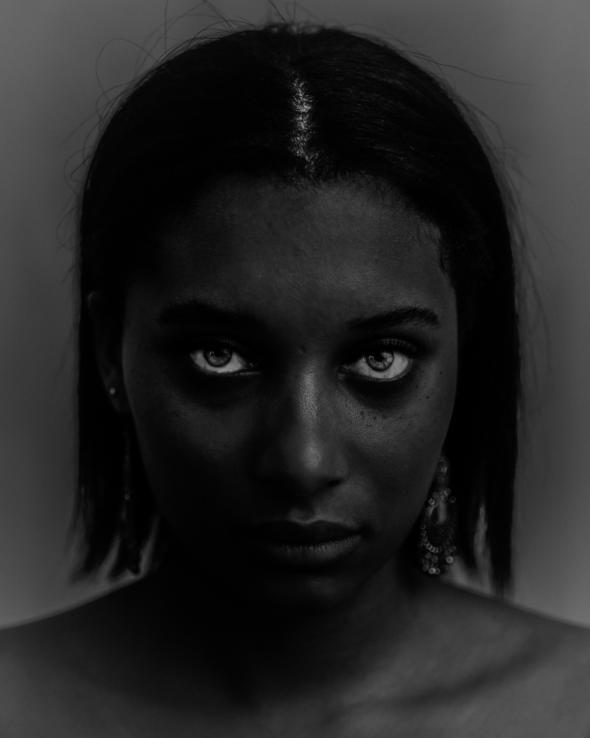 Beatriz
Beatriz
What brought you to Portugal?
Lisbon must have been one of the first multicultural cities in Europe, for thousands of years Portuguese people have been mixing different types of cultures. I came here and noticed the fantastic weather, great food, and nice people; and in a lot of ways, I’ve thought of Lisbon as the bridge between Europe and Africa.
Perhaps your mother’s cultural heritage made you want to explore more of Portugal?
I am not sure it was one of the reasons, not the main one. I lived in Colombia before moving to Portugal. Colombia has a very mixed culture; I remember a specific moment when I felt that living in Colombia was great because I could walk around, and everybody would think that I was Colombian and there are millions of people that look like me in some sort of sense.
Sadly, it was far from Europe, the equivalent of a day of travelling back to the UK, so I ended up deciding to stay in Europe in a place that celebrates mixed cultures. Lisbon seemed like an ideal place for that.
Do you feel like you can create here?
There is nowhere else in the world that I’ve ever been to that has such light like Lisbon and as a photographer this is great. For example, trying to be an artist in London requires a lot of competition which not only leads to extra high expectations, but often leaves creatives taking safer options as so much is on the line. Life is so expensive: and to have a studio space is crazy. Often you have to share it with four or five people to be able to afford it on a normal salary.
London is great for projects such as commercial photography because there are a lot of commercial interests and a lot of people wanting to commission these types of jobs, however that kind of photography has never really interested me that much. To work as an artist here makes sense because your money just goes a lot further.
Do you have a studio in Lisbon?
I do, it is a very small studio on my street, but it works. I have had it for two years now, I initially opened it in February 2020. I mostly just use it for shooting and a few other little experiments that I’m working on.
How did the pandemic affect your work?
It affected my work in a slightly less obvious way. During the first lockdown I decided to renovate the studio myself, I built a little set in there and a few other things so that I could shoot in there once the lockdown was lifted. After, I realised that there was not going to be enough paid work for the foreseeable future, so I started to sell my prints of projects I’d done previously in Cuba and São Tomé.
Until that point, I think my work had always been very documentary based: I would go to a place I’d never been before and use photography as a way of trying to understand and process that new environment.
When the lockdown was lifted, I started interviewing, shooting people and writing about their lives, translating their feelings and experiences into my projects.
Towards the end of the year, in September, I went to Geneva to do an exhibition. I’d never been to Switzerland before, although I was well aware of the monied culture. When I turned up at the exhibition I had expected all these men in suits, but in reality it was the absolute opposite; the crowd was young, funky and multicultural. Many themselves were mixed and I learnt so much from the few minutes I spoke to each of them that it drove me to learn more about what it means to be mixed.
As I stood there, most of them used the words “I have a boring job” be it a lawyer, an economist etc, but nearly every one of them had a creative side-hustle in the arts. It blew my mind that such polar-opposite mindsets could exist within the same person. This made me realise that I inherited very different qualities from both my parent and it lead me to begin my own project about people with mixed heritage in order to understand more about mixed culture, but also to better understand myself.
What do you seek to broadcast through your art?
 JohannaMy work has always been focused round connection. I’ve always wanted to tell stories that even though you know the audience and the subject might be different I would want the audience to look at the photo, the subjects, and each detail and for them to be able to see something similar.
JohannaMy work has always been focused round connection. I’ve always wanted to tell stories that even though you know the audience and the subject might be different I would want the audience to look at the photo, the subjects, and each detail and for them to be able to see something similar.
Most people that look at my most recent project “MIXED” and probably don’t necessarily think of themselves as mixed, however if we really look back at history and ethnicity it’s clear that we are all mixed, we just haven’t identified it . We all came from Africa and our genetic disposition is remarkably similar. The only differences we notice are as a result of our ancestors colonising different parts of our planet. Effectively we’re all mixed as racial purity is a complete myth.
I have always wanted to tell the stories that bring humanity together rather than splitting people apart. Although there is amazing and important work out there, there are many photographers that portray awful subjects which are sad, and terrifying. For the record, this is necessary work but personally I’ve always wanted to put a positive spin on life because I feel as though hope is a more important emotion that fear or sadness.
You shot a project with FUBUNATION called “Dance Me to Death”. Can you tell us more about it? How where you able to portray dance, constant movement, in a still?
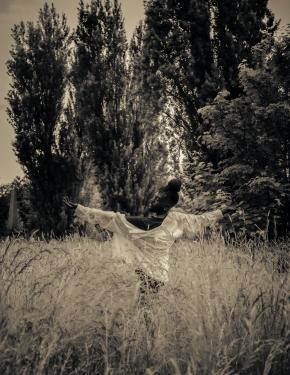 Waddah
Waddah 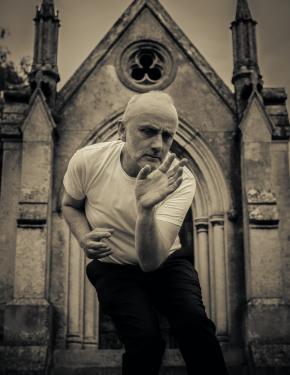 Vince
Vince
I got invited for what was a performance of over 50s at Kensal Green Cemetery in London to commemorate those who had died from Covid and I was shooting the people that were taking part of the performance. Rose, the lady who organised wanted to bring us all together through dance and photography and was a way for people people to help deal with the losses of loved ones during the pandemic.
I’d met them before the shooting day, at one of the rehearsals, but decided to work fully on instinct and see how would that be reflected in the resulting photos.
I think dance and photography are a match made in heaven. They work so well together. I often use a slightly slower shutter speed which results in motion blur, which can be very dramatic. I am working with the choreographers again next month a new show entitled “BLACK IS…”.
Why choose to work with Black and White only?
I personally think colour photography can be incredibly distracting because when you look at it almost the first thing you see are the colours. My personal ambition in photography is to capture the person behind whatever shield or armour they put up.
When I was learning photography, even now, my main influences were documentary photographers from the 40s and 50s. Now, I refer to greats like Erwin Blumenfeld and Man Ray. I look at their work and I feel as though it’s still cutting edge. For me, this is the type of work that stands the test of time. I want people to look at my work in the future think it that could’ve been taken last week.
Taking photographs of people of colour in colour historically has also been extremely challenging. It’s extremely difficult to get the skin tones right because film wasn’t originally designed for people of darker complexion. Working with actual film back in the day, black skin tones would often come out overly dark as the film would read them as shadows.
You have an ongoing project called “MIXED” where you explore racial and cultural identity. What story impressed you more?
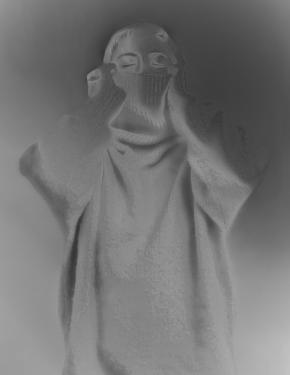 Jenifer They all have amazing stories, one of the reasons why I interview my guests beforehand is to put both of us at ease and I am continually surprised by their stories. It’s one of life’s great truths that you ask the right questions in the right way people will let you in on their most intimate experiences.
Jenifer They all have amazing stories, one of the reasons why I interview my guests beforehand is to put both of us at ease and I am continually surprised by their stories. It’s one of life’s great truths that you ask the right questions in the right way people will let you in on their most intimate experiences.
One of the stories that sticks in my mind, is Jenifer’s. I think we talked more than 2 hours straight! Jennifer is half Japanese, and half American and lives here in Lisbon; she grew up in a tiny place called Columbus in Alabama where she was essentially the product of a one-night stand when her mother was fifteen. When her mother gave birth to her, she left her at the hospital because she could not take care of the baby. Her father wanted nothing to do with her, so parents of the father were called, and adopted by them.
She grew up thinking that she was white as none of the family mentioned her Japanese roots, even though she privately questioned her surroundings and expressed feelings of displacement. One day when she was 12 or 13 her grandparents took her to court because her mother had been trying to see her. She finally met her mother in court that day. Jenifer wanted to keep seeing her, but her grandparents were against the idea and eventually made her choose between her mother and them. She chose her mother and they cut her out of the family. Sadly, Jenifer’s mother became very abusive towards her and she ran away from home several times. She even spent time in Juvenile Detention Centres until she finally emancipated when she was 16. She has lived in various cities on both coasts in the US, Berlin and now Lisbon.
Passing is a concept historically known. People deny themselves their right to be who they want because of what is expected by society…
I did not really grow up around that mixed people. When I was in London there was very few mixed people, very few mixed relationships. It’s now it is common, fashionable even, but back then it really was not.
I think when mixed people meet other mixed people you have these conversations that include familiar experiences. I often feel more at home around us than maybe I do around other people.
Part of the reason why I did the projects was to almost create an archive that future generations can look at and help to decode their own experiences and what they are going through. The way the world is going at the moment there will be more and more mixed kids in the future. In a way, it’s the blurring of the races. Effectively we are all getting browner.
Some people have a hard time accepting that mentality…
When I started doing this project Trump was still President, Bolsonaro is obviously still President, you got Boris Johnson in the UK, Viktor Orbán in Hungary, Narendra Modi in India, Imran Khan in Pakistan, Putin in Russia… the list goes on. These are very divisive people and I think that we need to be having discussions that are inclusive not exclusive. The conversation should be about how to include all of us, because humanity is stronger when we join together than when we’re pulled apart.
What are your thoughts on the escalating tensions around Europe?
Almost all the problems that exist in the world today in terms of geographical conflicts, religious conflicts, and even social conflicts in less developed parts the world like the Middle East, Africa and Latin America it is being caused by European colonialism.
The British and the Americans went into the Middle East after the Second World War and started drawing lines in the desert, they basically started separating groups of people: tribal groups of people that lived there for thousands of years living for the mostly in peace but and as soon as you start saying pulling groups apart, taking away their homelands you’re going to have problems.
Going to places like Africa/South America where there are so many natural resources and you are going to steal them to enrich your own countries, of course there’s going to be conflict over what’s left. I think Europe and other parts of the West are essentially feeling the delayed effects of that greed.
Have you ever photographed yourself?
Yes, I have, mostly to illustrate the things that I was talking about before, things like racism particularly in the aftermath of George Floyd’s murder. There are a few photographs I took of myself, I rarely do it, but there is one in particular which I am very pleased and proud with all the rope tied around my head.
I prepared the camera tripod and was just playing around with a few things before beginning to wrap the rope around my head. I used a self-timer to take the photo.
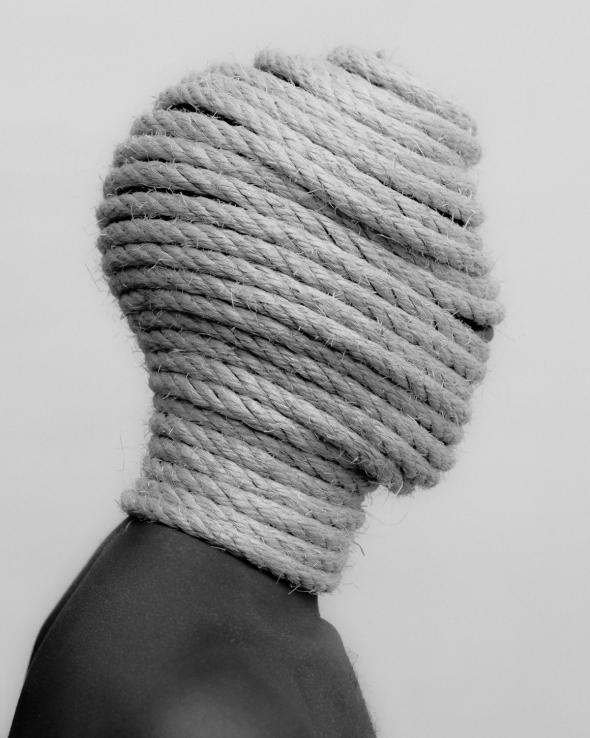 Claustrophobia
Claustrophobia
Is there a meaning to the rope?
I wanted to express the sense of claustrophobia: when you are of colour in a majority white country it can be very difficult to really be yourself because of people judging you, trying to put you in a box, telling you that you are a certain way, that you can’t certain things. It feels claustrophobic. Of course there is a double meaning as well because of the historical context of rope in relation to Black people.
What would your story be?
I feel very lucky that I come from quite a colourful family, I know a lot more about my Jewish side than my African side because my mom was adopted. My great-grandfather lived in Iran and his job was to stamp bales of cotton with the logo Manchester onto it. His father owned the company he worked for, but they were losing money because of the agent fees paid at the time. He said to his father that instead of paying the agent, he would go to Manchester and set up like cotton business there where he could buy from his father directly. It took him a number of years, working in one place in order to get to the next, but he effectively walked all the way to Manchester.
On arriving in Manchester, it clearly was not what he was expecting but at the time Manchester was the biggest textile city in Europe. He soon realised that factories were throwing out unused threads and offcuts. Instead of letting it go to waste, he’d repackage them and sell them in the local market, before starting his own textile factory. Eventually he worked his way up to be the richest man in Manchester until he lost everything.
This is one story on one side of my family, I also have another from a different great-great-grandfather from my grandfather’s side who was from Eastern Europe, and he had to escape the Cossacks riding in from Russia who were famed for slaughtering the Jewish people that lived in that part of Eastern Europe. He managed to get to what was then Danzig in the north of Germany and embarked on a ship that was meant for New York. Apparently this was a famous con and the captain, instead of going to New York, sailed to Liverpool and shouted “New York” and everybody got off. Before anyone had realised the ship had already left and all the passengers were stranded in the north of England.
I was born in London, and I went to virtually the same school from the age of four until I was eighteen. I was one of maybe three or 4 kids of African origin in the entire school, so I grew up around a lot of white people. I left school to do a philosophy degree that I believe really changed the way I think.
I left my university after I finished my degree I worked as a tailor, on Savile Row. Five years later I left the UK and went to Colombia. I went there with no plan, was learning Spanish and trying to connect with my surroundings, understand the culture. I bought a tiny camera with the aim of taking some travel photos.
Was that how you discovered your interest in photography?
While I was there, I got invited on a photo walk with all these photographers; all of whom had much more professional kit than me. We had a competition of who shot the best photo of the day and I happened to win the contest. I remember thinking to myself that maybe there was something to this photography thing. The organisers of the walk ran a Photography Institute, so I signed up to do a one night a week photo walk on the weekends course over three months. My Spanish at the time was terrible, so I didn’t understand much, but I still learnt a lot.
For the end of the course, we had to do a project, mine was about this particular neighbourhood called Enciso which historically was very violent because of the drug wars. Many Colombians gasped in fear at even the mention of it, so my intention was to myth bust that notion by doing a story on the vibrance of the nightlife.
That was my first ever project and the teacher who ran the course liked it so much that he got it published in El País. After that I had felt as though photography really was something that I enjoy doing, I feel like I have a voice and something unique to say, so I continued.
I really enjoying connecting with people and the camera was a way for me to connect with Colombian culture and it also doubled almost as a passport that allowed me into people’s homes and lives. That’s how I developed the habit of having a conversation with someone before taking their photo.
All those experiences, family histories, crossing borders, people trying to find their place in the world, forging connections with people, all being pushed into me in some way, and as a result I have been trying to translate that into my photography.
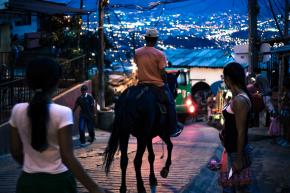 Night time in Enciso.
Night time in Enciso.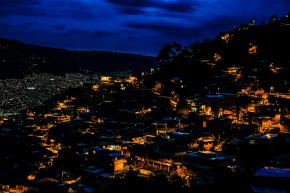 Night time in Enciso.
Night time in Enciso.
Learn more about Theo’s work and the people he photographed here. You can currently see his work at HANGAR untill the 19th of March.